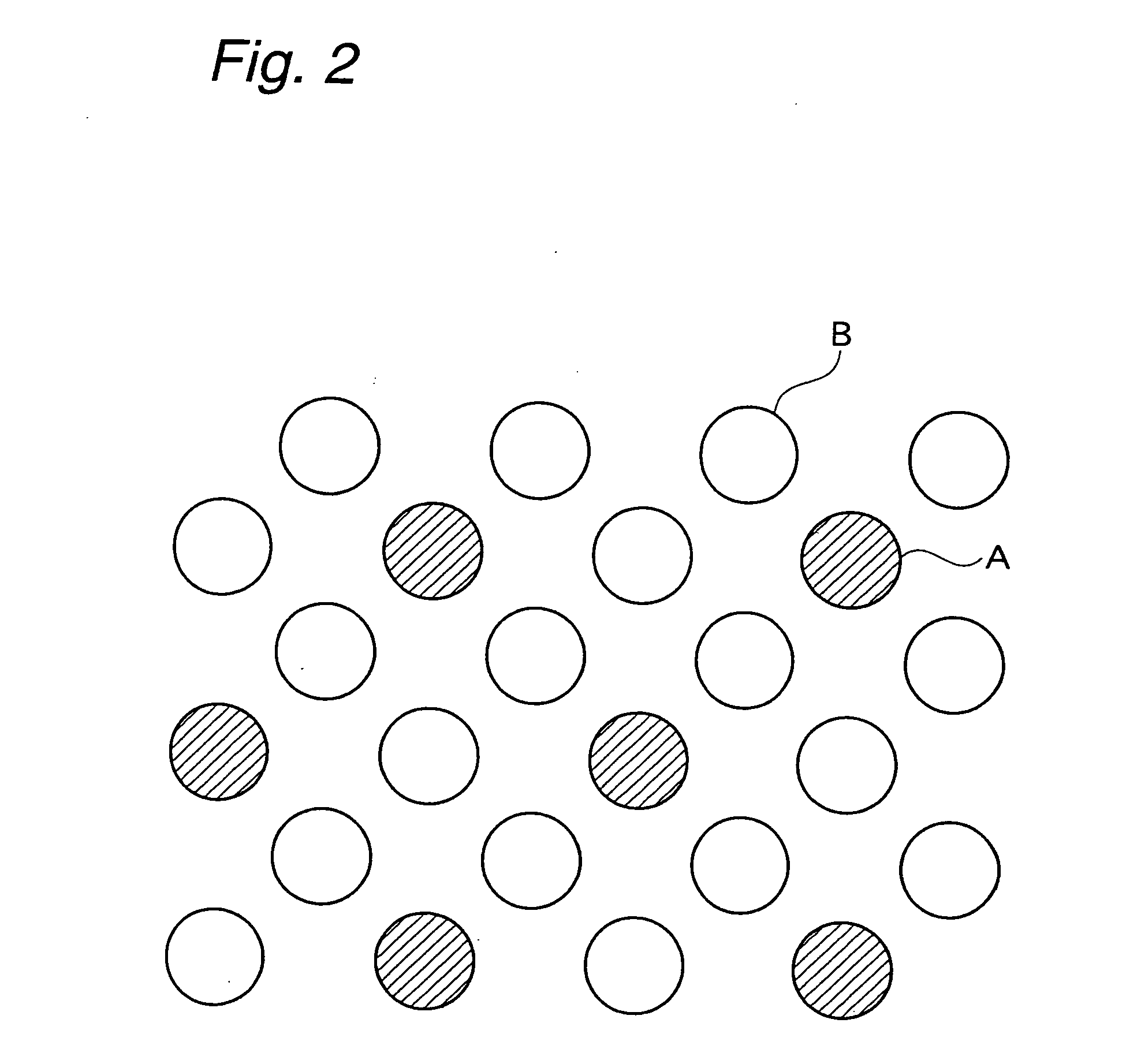Mixed fiber and, stretch nonwoven fabric comprising said mixed fiber and method for manufacture thereof
a technology of nonwoven fabric and mixed fibers, which is applied in the direction of weaving fabrics, textiles and papermaking, weaving, etc., can solve the problems of insufficient elastic properties of applications such as garments, failure to obtain nonwoven fabrics having desired fiber diameters, and difficulty in achieving the desired fiber diameter, etc., to achieve excellent heat sealing properties and productivity, low residual strain, and beautiful spinning
- Summary
- Abstract
- Description
- Claims
- Application Information
AI Technical Summary
Benefits of technology
Problems solved by technology
Method used
Image
Examples
production example 1
TPU Production Example 1
[0127] In an atmosphere of nitrogen, 280.3 parts by weight of 4,4′-diphenylmethane diisocyanate (hereinafter “MDI”) (trade name: Cosmonate PH, available from Mitsui Takeda Chemicals, Inc.) was placed in an isocyanate compound storage tank (hereinafter “tank A”) and heated to 45° C. with agitation while avoiding bubbles.
[0128] Separately, a polyol storage tank (hereinafter “tank B”) was charged under a nitrogen atmosphere with:
[0129] 219.8 parts by weight of polyester polyol having a number-average molecular weight of 1000 (trade name: Takelac U2410, available from Mitsui Takeda Chemicals, Inc.);
[0130] 439.7 parts by weight of polyester polyol having a number-average molecular weight of 2000 (trade name: Takelac U2420, available from Mitsui Takeda Chemicals, Inc.);
[0131] 2.97 parts by weight of bis(2,6-diisopropyl phenyl) carbodiimide (trade name: Stabilizer 7000, available from RASCHIG GmbH);
[0132] 2.22 parts by weight of a hindered phenolic antioxidant ...
production example 2
TPU Production Example 2
[0140] In a nitrogen atmosphere, 288.66 parts by weight of MDI was introduced into the tank A and heated to 45° C. with agitation while avoiding bubbles.
[0141] Separately, the tank B was charged under a nitrogen atmosphere with:
[0142] 216.2 parts by weight of polytetramethylene ether glycol having a number-average molecular weight of 1000 (trade name: PTG-1000, available from Hodogaya Chemicals);
[0143] 432.5 parts by weight of polyester polyol having a number-average molecular weight of 2000 (trade name: Takelac U2720, available from Mitsui Takeda Chemicals, Inc.);
[0144] 2.22 parts by weight of Irganox 1010; and
[0145] 2.22 parts by weight of JF-83.
[0146] The contents were brought to 95° C. under agitation. This mixture will be refereed to as the polyol solution 2.
[0147] Subsequently, 62.7 parts by weight of a chain extender, 1,4-butanediol, was introduced into the tank C in an atmosphere of nitrogen and brought to 50° C.
[0148] These materials had amou...
production example 3
TPU Production Example 3
[0152] In an atmosphere of nitrogen, MDI was placed in the tank A and heated to 45° C. with agitation while avoiding bubbles.
[0153] Separately, the tank B was charged under a nitrogen atmosphere with:
[0154] 628.6 parts by weight of polyester polyol having a number-average molecular weight of 2000 (trade name: Takelac U2024, available from Mitsui Takeda Chemicals, Inc.);
[0155] 2.21 parts by weight of Irganox 1010; and
[0156] 77.5 parts by weight of 1,4-butanediol.
[0157] The contents were brought to 95° C. under agitation. This mixture will be refereed to as the polyol solution 3.
[0158] These materials had amounts that would allow estimation of the hard segment amount to be 37.1 wt %.
[0159] Thereafter, MDI and the polyol solution 3 were supplied though liquid-supply lines with gear pumps and flow meters at constant flow rates of 17.6 kg / h and 42.4 kg / h respectively to a high-speed stirrer (Model SM40) temperature-controlled at 120° C. After they had been ...
PUM
| Property | Measurement | Unit |
|---|---|---|
| diameter | aaaaa | aaaaa |
| wt % | aaaaa | aaaaa |
| temperature | aaaaa | aaaaa |
Abstract
Description
Claims
Application Information
 Login to View More
Login to View More - R&D
- Intellectual Property
- Life Sciences
- Materials
- Tech Scout
- Unparalleled Data Quality
- Higher Quality Content
- 60% Fewer Hallucinations
Browse by: Latest US Patents, China's latest patents, Technical Efficacy Thesaurus, Application Domain, Technology Topic, Popular Technical Reports.
© 2025 PatSnap. All rights reserved.Legal|Privacy policy|Modern Slavery Act Transparency Statement|Sitemap|About US| Contact US: help@patsnap.com



